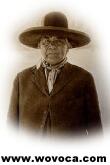|
||||||||||||||||||
Press CTRL+D to bookmark this page! |
||||||||||||||||||
 |
||||||||||||||||||
| Click here for
EarthMotherCrying Wallpaper |
||||||||||||||||||
Holy Tree: Dancing Mexican pilgrims pray at sacred ahuehuete |
||||||||||||||||||
|
||||||||||||||||||
|
||||||||||||||||||
|
|
||||||||||||||||||
|
||||||||||||||||||
|
||||||||||||||||||
Dancing Mexican pilgrims pray at sacred ahuehuete
By Elizabeth Fullerton c. Fox News September 18, 2000
CHALMA, Mexico — Just outside the hillside town of Chalma, 75 miles from Mexico City, umbilical cords, hand-knit booties and crucifixes hang from the boughs of a gigantic tree that many Mexicans believe to be sacred. Thousands of Catholic pilgrims flock to the site throughout the year to give thanks for prayers answered or make wishes at what is widely considered Mexico's second holiest shrine after the Basilica of the Virgin of Guadalupe in the capital.
While some other Mexican pilgrimages involve self-flagellation and suffering, with penitents hobbling on bleeding knees, pilgrims to Chalma pray through dancing.
"We come here every year," said Antonio Marillo Reyes from central Hidalgo state as he and 30 relatives enjoyed a picnic beside a spring gushing from the tree's roots. "All the babies in our family have been thrown in the spring water but it doesn't harm them. We are praying for work and good health."
In a sign of the ritual's joyful spirit, pilgrims buy a crown of flowers and dance as they offer up prayers. Then grannies join babies and couples to bathe in the icy waters.
Some pin notes or items reflecting their petitions and prayers to the tree, known locally as an "ahuehuete," which resembles a cypress. Women hang umbilical cords in small bags on the tree to give thanks for a successful birth. The pilgrimage ends in the church at Chalma a short distance up the road.
Prehispanic Indians Worshiped at Chalma
Chalma was a place of worship long before the 1521 Spanish conquest imposed Catholicism on Mexico. Indians in the region venerated a "god of the cave" in the surrounding mountains whose identity is disputed by anthropologists, according to Gabriel Moedano Navarro, ethnology professor at the traditional music and literature archives of the National Institute of Anthropology and History.
The god was variously identified with a deity of human destiny or of the night, sometimes taking the form of a jaguar, or with the god of war, depending on different Indian oral traditions. Few of the pilgrims who pray at Chalma today actually know the origin of the legend.
"It's a tradition our ancestors left us many many years ago," said Raphael Olivo Moya, who brought his young daughter from the working class district of Nezahualcoyotl in Mexico state. He has made the pilgrimage three times.
According to some versions, two friars arriving at the cave soon after the Spanish invasion destroyed the Indians' idol.
"They returned with a wooden cross to put in its place but miraculously, so the saying goes, there was already a crucifix with a black Christ and the entrance was full of exquisite flowers," Moedano said. "They say that from that point, people started to worship the Senor de Chalma (a version of Jesus)."
Olivo Moya is a fervent believer in God's powers. "Whatever I've asked him for, he's granted," he said, crossing himself three times. "Three years ago I came and prayed that I should never be without work and now I have my own business."
Throughout Latin America, local lore is full of similar legends that some scholars say were propagated by the Spanish conquerors to win over the indigenous population by melding their religious symbols with Catholic ones.
The Virgin of Guadalupe, Mexico's most cherished icon, is said to have appeared to an Indian peasant called Juan Diego in the form of a dark-skinned Mary in 1531.
Chalma Musicians From One Family
Outside a small church by the road across from the sacred tree, Arnulfo Linares, in Stetson hat, jeans and cowboy boots, prepared to scratch out a tune on his violin. "All those who still have to dance step this way," he said, his gold tooth flashing as he spoke.
Wearing colorful flower crowns, pilgrims of all ages shuffled around the patio outside the church. Women in shawls jiggled newborn babies up and down on the spot.
People used to dance around the tree but it began to suffer damage and a dance area was created outside the nearby church.
After five minutes, Linares passes around, collecting five pesos (50 cents) from each person. Generations of the Linares family have provided music for Chalma's dancing pilgrims.
"We've played here during the wars in Mexico. My grandfather braved guns and everything. We never stopped," he said.
The shrine has spawned an industry, with stalls selling religious trinkets and plastic bottles for the spring water. Rich aromas of Mexican fare waft from makeshift restaurants where hungry pilgrims, many of whom travel two or three days across the mountains from Mexico City, stop for a bite to eat.
Women laden with crowns of flowers line the side of the road, selling three for just 10 pesos. Two shy elderly women with long gray plaits tied together at the ends sit on buckets near one restaurant, weaving roses, bougainvillea and carnations together to make the crowns.
"I've been doing this as long as I can remember," one said. "I used to come here with my mother. We grow the flowers ourselves."
The Chalma tradition has even seeped into local language. A popular Mexican saying goes that if a cause is hopeless, it cannot be redeemed, "not even by going to dance at Chalma." |
||||||||||||||||||
|
||||||||||||||||||
|
||||||||||||||||||
|
||||||||||||||||||
Shapeshift to WOVOCA! to view this site's main page |
||||||||||||||||||
|
||||||||||||||||||
|
||||||||||||||||||
|
||||||||||||||||||
|
||||||||||||||||||
|
||||||||||||||||||










![[Image]](pict41.jpg)
![[Image]](pict43.jpg)